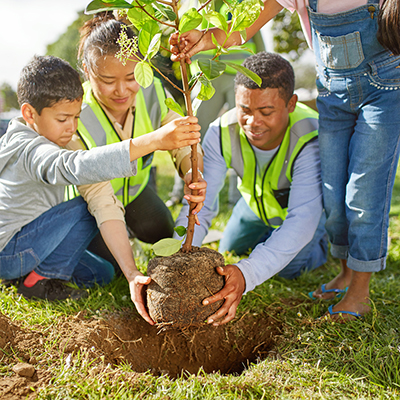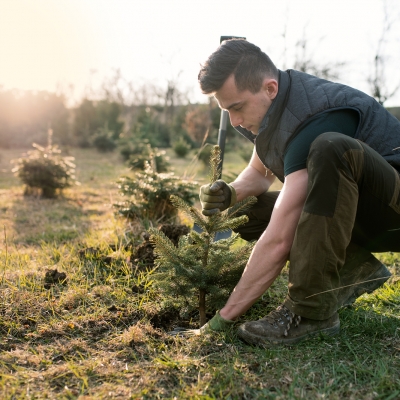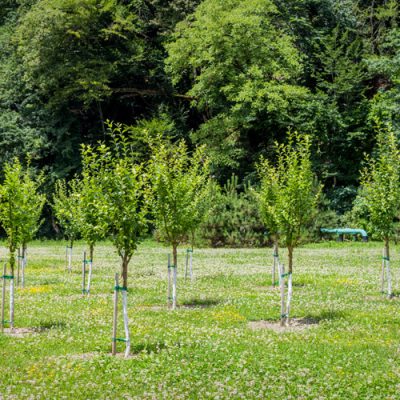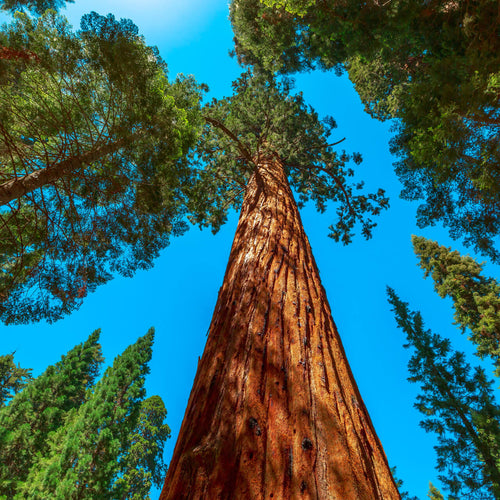1. Unwrap The Tree or Remove it from its Container
2. Dig a hole twice as wide and 1.5 times as deep as the circumference of the roots.
3. Have rich potting soil on hand, and once the tree is inserted in the hole, cover it with the soil from which the hole was dug and the rich potting soil.
4. Stomp the soil in and pack well with your feet around the tree's main trunk.
5. Use tree stakes to support the tree well to keep it from falling over to one side or becoming uprooted from the soil.
6. Water the well the first five days after planting.
TN Nursery Offers Helpful Gardening Advice
Growing a tree is more than drilling a hole and putting a sapling in it. It is a powerful act of nurturing life, contributing towards a greener environment, and investing in the future of our planet. Proper tree planting needs careful contemplation of factors such as soil type, weather conditions, and location to ensure the tree thrives and becomes a valuable asset to its surroundings. This comprehensive guide will delve into the sophistication of planting trees, exploring the art of successful tree establishment and various steps and techniques necessary to ensure the tree's healthy growth.
Choosing the Right Tree
Selecting the perfect tree species is a crucial first step when planting trees. It is essential to consider various factors such as the climate, soil type, available space, and intended purpose of the tree. When choosing the tree species, it is highly advisable to pick native species that are well-adapted to local conditions and can help maintain local ecosystems. To guarantee the tree will flourish in its planting site, you must evaluate its mature size, growth rate, and environmental requirements. This will help you determine if the tree is compatible with its planting site and help you plan accordingly to give it the best chance of survival.

Properly organizing the planting location is of utmost importance for a tree's long-term health and growth. To ensure this, you should start by clearing the area of any debris, rocks, or competing vegetation that might obstruct root development, as this can significantly impact the tree's overall health. Once the area is cleared, dig a hole broad sufficiently to adjust the root ball, with some extra space for growth. The depth of the hole should be equivalent to or slightly shallower than the root ball's height, as this will prevent the tree from settling too deeply, which can also cause harm to the tree's health. By following
Handling and Planting the Tree
When planting a tree, handling it with utmost consideration is crucial to prevent any damage to its delicate root and stem systems. If the tree comes in a container, it should be gently removed so as not to disrupt the roots excessively. In the case of a bare-root tree, it is essential to examine the roots for any signs of injury or disease before planting. So as to ensure that the roots are well-hydrated, soaking them in water for a few hours before planting can be helpful.

Once planted, the tree should be positioned in the center of the prepared hole, ensuring it is straight and upright. Any loose soil or debris should be removed from around the hole to prevent damage to the roots. When backfilling the hole with soil, it is essential to be gentle and firm to ensure the soil is well-settled around the roots, eliminating any air pockets. These steps will help ensure the tree has the best chance of thriving in its new environment.
Watering The Tree
Applying mulch around the tree's base helps conserve moisture, suppress weeds, and regulate soil temperature. Apply a coating of organic mulch, such as wood chips or slivered bark, around the tree, leaving a gap between the mulch and the trunk to prevent moisture-related issues. Water the just planted tree entirely to fix the dirt and supply essential moisture to the roots. Monitor the soil moisture regularly, especially during dry periods, and adjust the watering frequency to keep the soil moist but not waterlogged.
When you plant a new tree, it's important to remember that it may require additional support to avoid leaning or toppling over. To provide support, you can install stakes on opposite sides of the tree and secure them with flexible ties, ensuring you don't constrict the trunk. It's essential to check the tension of the relationship periodically and adjust it as needed to accommodate the tree's growth while still providing adequate support. This will help the tree develop straight and tall without damage or stress. Once the tree establishes a robust root system and can support itself independently, you can release the stakes and ties. This will allow the tree to develop without restrictions and help it thrive for years.
Once you have planted your tree, keeping a close eye on its growth and health is essential. Check for any signs of stress, such as leaves that are wilting or brown or indications of pest infestations. If any issues are detected, promptly take action to avoid further damage.

To encourage healthy growth and create an attractive canopy shape, it's helpful to prune any damaged or dead branches. This will also help the tree to put more energy into growing new, healthy branches. When fertilizing your tree, it's essential to be cautious and follow the recommendations based on soil tests. Over-fertilizing may lead to excessive growth and can harm the tree's health.
By providing your newly planted tree with the proper maintenance and attention, you can encourage it to thrive and contribute to the beauty of its surroundings for many years to come. You can appreciate observing your tree grow and flourish with regular care and attention.
Planting a tree is a truly satisfying endeavor that can positively affect the environment and future generations. By following the comprehensive steps outlined in this guide and investing ample time and effort in proper tree establishment, we can effectively create a greener, more sustainable world. It's essential to bear in mind that every tree we plant has the potential to make a significant impact, providing a valuable source of shade, much-needed oxygen, and a vital habitat for various forms of wildlife. By planting a tree, we are making a tangible difference in preserving the planet for the future.



















































